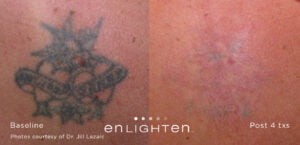We’ve all been there – that impulsive decision to get a tattoo that seemed like a great idea at the time but now leaves you with some serious ink regrets. You’re not alone! Thanks to the wonders of modern technology, tattoo removal has become a safe and effective option for those who want to bid farewell to their unwanted body art.
You don’t have to live with an unwanted tattoo that reminds you of a painful time in your life. Instead, choose tattoo removal for a fresh start. Here are ten essential things to know about tattoo removal, so you can confidently plan your ink-erasing journey.

1. Have Patience
Tattoo removal is not an instant process. While advancements in laser technology have made it faster and more efficient, it still takes time for your body to eliminate the tattoo ink naturally.
Multiple sessions are usually required to achieve optimal results, and you’ll need to space them out to allow your skin to heal properly. The size of your tattoo and the density of the ink will all play into the schedule for tattoo removal.
2. Choose a Reputable Clinic
When it comes to tattoo removal, trust is paramount. Research and select a reputable clinic with experienced professionals who specialize in laser tattoo removal.
Look for clinics with state-of-the-art equipment and a proven track record of successful treatments. Feel free to ask for before and after photos or read customer reviews to ensure you’re making an informed choice. A trusted clinic should be transparent about its safety protocols, history of results, and tattoo removal process.
3. Understand the Laser Technology
The most common method for tattoo removal is laser technology – specifically, Q-switched lasers that emit high-energy light pulses. These pulses break down the tattoo ink into smaller particles, allowing your body’s immune system to flush them out gradually.
Different ink colors respond to different laser wavelengths, so make sure the clinic you choose has the appropriate equipment to target your specific tattoo. Ask questions about your tattoo and make sure the clinic has relevant experience and knowledge.
4. Look into Pain Management Options
Let’s address the elephant in the room – does tattoo removal hurt? The sensation can vary from person to person, but many individuals describe it as similar to getting a tattoo or a rubber band snapping against the skin.
Most clinics offer pain management options such as topical anesthetics or cooling devices to minimize discomfort during the procedure. Work with your trusted clinic to find pain management options that help you feel comfortable and at ease during the procedure.
5. Consider the Tattoo Location
The location of your tattoo plays a role in the removal process. Tattoos located closer to your heart and with better blood circulation tend to fade more quickly since the immune system can access the ink particles more effectively. Areas with thinner skin, like the wrists or ankles, may require additional sessions for complete removal.
In addition, some areas of the skin are more sensitive. Prepare with pain management depending on the area of the body you have a tattoo that needs removing.
6. Ask About Safety Precautions
Tattoo removal is a safe procedure when performed by trained professionals. However, it’s important to follow pre- and post-treatment instructions carefully. This includes avoiding sun exposure, applying sunscreen, and keeping the treated area clean and moisturized.
Adhering to these guidelines will help minimize the risk of complications and ensure optimal healing. Speak with your clinic about safety protocol to ensure you will minimize the risk.
7. Set Expectations and Know the Limitations
While tattoo removal technology has advanced significantly, it’s essential to have realistic expectations. Complete removal of a tattoo is not always possible, especially for multicolored or heavily pigmented tattoos.
Some ink colors, like vibrant blues and greens, can be more challenging to eliminate. Your clinician will honestly assess what to expect based on your specific tattoo.
8. Educate Yourself About Potential Side Effects
Tattoo removal is generally a safe procedure, but like any medical treatment, it carries some risks. Temporary side effects can include redness, swelling, blistering, or scabbing, which usually subside within a few weeks.
In rare cases, more severe side effects like scarring or skin discoloration may occur. Discussing the potential risks with your clinician before starting the removal process is crucial.
9. Budget for Tattoo Removal
The cost of tattoo removal varies depending on factors such as the size, color, and complexity of your tattoo and the number of sessions required. Some clinics offer pricing packages or discounts for multiple treatments.
While it may require a financial investment, many individuals find it worth the expense to regain confidence in their appearance. Instead of waiting, look for a financing package to help you move on with your life after tattoo removal.
10. Allow for an Emotional Response
Lastly, remember that tattoo removal is not only a physical journey but an emotional one as well. It’s okay to have mixed feelings about letting go of a piece of your past.
Reach out to supportive friends, family, or even consider joining online communities of individuals going through the same process. Celebrate each step forward and embrace the fresh start that awaits you.
Choose a Trusted Provider for Tattoo Removal
Tattoo removal offers a ray of hope for those seeking a clean slate on their skin. With patience, research, and the guidance of professionals, you can bid farewell to tattoo regrets and embark on a journey towards tattoo-free skin.
Remember to set realistic expectations, follow proper aftercare, and take care of your emotional well-being throughout the process. Soon enough, you’ll be ready to embrace the new you that is more representative of who you are today.
Contact Elite Body + Laser to talk about your options for tattoo removal. We can introduce pain management options and talk about the removal process for your specific tattoo.

